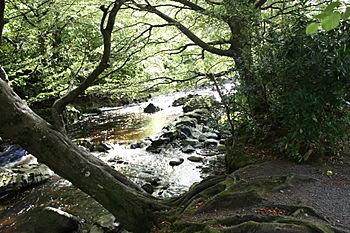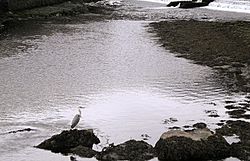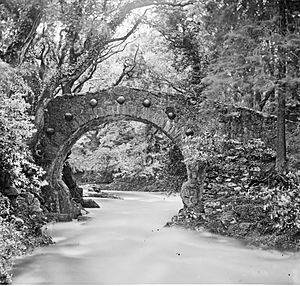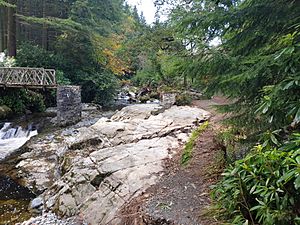Shimna River facts for kids
Quick facts for kids Shimna River |
|
|---|---|

Shimna River in Tollymore Forest Park, September 2010
|
|
| Lua error in Module:Location_map at line 420: attempt to index field 'wikibase' (a nil value).
Location of mouth within Northern Ireland
|
|
| Country | Northern Ireland |
| Region | County Down |
| Physical characteristics | |
| Main source | Mourne Mountains on the slopes of Ott Mountain 430 m (1,410 ft) |
| River mouth | Dundrum Bay, Irish Sea 5 m (16 ft) |
| Length | 11.77 km (7.31 mi) |
| Basin features | |
| Tributaries |
|
The Shimna River is a cool river in County Down, Northern Ireland. Its name, Simhné, means "river of bulrushes" in Irish. This river starts high up in the Mourne Mountains on Ott Mountain. It then flows all the way to the Irish Sea at Newcastle, which is on Dundrum Bay.
The Shimna River is special because its water is a bit acidic and doesn't have many nutrients. This means you'll mostly find mosses and liverworts growing there. Some of these plants are quite rare! Important fish like salmon and sea trout live in the river. The Shimna Angling Club helps look after the river. It's also known as an Area of Special Scientific Interest (ASSI) because of its unique nature.
Contents
Journey of the Shimna River
The Shimna River begins its journey in the Mourne Mountains, high up on Ott Mountain. From there, it flows north into Fofanny Dam. It then turns northeast and enters Tollymore Forest Park. Here, two smaller rivers, the Spinkwee River and Trassey River, join it.
The Shimna River then flows east, before turning southeast towards Newcastle. It even passes through a place called Tipperary Wood. Before reaching the sea, the Burren River and the Tullybrannigan River join it at Islands Park. Near the end, as it goes through Castle Park, the river gets wider. It creates a shallow pond where people used to enjoy boating.
Rocks and River Flow
The Shimna River is a "spate river." This means it can become deep and fast-flowing after a lot of rain. But when the weather is dry, it becomes slow with low water levels.
In flatter parts of the river, you can see small rapids called riffles and calm pools. The river banks are sandy, and the river bed has pebbles and scattered boulders. Where the river flows downhill more steeply, the water moves faster. Here, you'll find rapids and cascades, and the river bed is made of solid rock and large boulders.
The rocks in the upper part of the river, in the Mourne Mountains, are made of granite. This granite formed about 50 million years ago. As the river flows through Tollymore, the bedrock changes to shale. This shale is much older, from the Silurian age, over 400 million years ago. It forms step-like gorges along the river banks. You can also see dark bands of basalt rock. These formed when hot, melted rock pushed through cracks in the bedrock about 60 million years ago. The river bed also contains stones and gravel that were carried there by giant ice sheets during the last ice age. These stones came from places as far away as Antrim, Tyrone, and Scotland.
River History and Bridges
In 1588, Felix Magennis built a castle right next to where the Shimna River meets the sea. This town was called New Castle even back in 1433, so it's likely he built his castle on top of an older building. Magennis's castle was taken down in 1830.
The Shimna River has 16 bridges as it flows through Tollymore Forest Park. The oldest bridge still standing is the Old Bridge, built in 1726. The Ivy Bridge was built in 1780, and Foley's Bridge in 1787. Parnell Bridge, built in 1842, was the last stone bridge constructed in Tollymore. Newer footbridges are made of wood. Castle Bridge is near the river's mouth, where Main Street crosses. It used to be called Fearsat an Chaislein Nui, meaning "The Ford or Pass of the Newcastle."
There's also a small stone shelter called The Hermitage built into the side of the gorge above the river. It was designed in the 1770s as a place for ladies to rest while the men went fishing.
Between 1994 and 2003, some ancient flint tools were found near the Shimna River. These included flakes, blades, and a scraper. Some were from prehistoric times, and one blade was from the Late Mesolithic or Early Neolithic period. A Bronze Age arrowhead was also found nearby.
River Flooding
The Shimna River has flooded several times. This can happen after very heavy and long-lasting rain.
Flooding in 2008
On August 16 and 17, 2008, there was a big flood in the area. It mainly affected Bryansford Avenue and Shimna Road, damaging about 40 homes. The Rivers Agency, a government group, looked into it. They found that the amount of water in the rivers was too much for the flood defenses and natural river banks. The flooding happened because the Shimna River overflowed into the Burren River area through Islands Park.
Flooding in 2020
Another major flood happened on August 25 and 26, 2020, during Storm Francis. The Shimna River burst its banks. Rescue teams helped people, and some older residents were moved from their homes. The Infrastructure Minister said that work to help prevent future floods on the Shimna River would start soon.
The flooding also caused damage in Tollymore Forest Park. Several wooden bridges were washed away.
River Plants (Flora)
The Shimna River's water is low in nutrients and a bit acidic. This affects what plants can grow there. Mosses and liverworts are the most common. Near the river's source, you'll mostly find compressed flapwort (Nardia compressa) and green algae. Closer to the mouth, you can also see water earwort (Scapania undulata), feather moss, and bulbous rush (Juncus bulbosus).
Holt's mouse-tail moss (Isothecium holtii) grows a lot on the banks. The Shimna River is one of only three places in Northern Ireland where this moss is found. It's also the only known place in Northern Ireland to find Portuguese feather-moss (Platyhypnidium alopecuroides).
Other interesting plants include:
- Rusty feather-moss (Brachythecium plumosum)
- Fox-tail feather-moss (Thamnobryum alopecurum)
- Yellow fringe-moss (Racomitrium aciculare)
- Overleaf pellia (Pellia epiphylla)
Common trees along the river banks are oak, beech (Fagus sylvatica), ash (Fraxinus excelsior), birch, and willow. You might also see rhododendron, elderberry, blackberry, laurel, and ivy in some areas.
River Animals (Fauna)

Atlantic salmon, brown trout, and sea trout use the river to lay their eggs. Other fish you might find are Three-spined stickleback, minnow, stone loach, and eel. Birds like Dippers and Grey wagtails feed on insects along the river.
You can also find tiny creatures like leeches, black flies (Simulidae), and freshwater limpets (Ancylidae). Different types of Mayflies, Stoneflies, and caddisfly larvae also live in the river.
Since 1978, a group of wild Mandarin ducks has lived on the river. You might also spot kingfishers and grey herons. Otters are often seen near the mouth of the river.
Fishing in the Shimna River
The Shimna Angling Club manages the fishing on the river. The main fish caught here are salmon and sea trout. In 1983, a record-breaking sea trout was caught in the Shimna. It weighed 16 pounds and 6 ounces (about 7.43 kg), making it the largest sea trout ever caught in Ireland! The fishing season runs from March 1st to October 31st.
Pollution and Fish Deaths
Sadly, the Shimna River has had some problems with pollution and fish dying.
In 2004, a pipe broke during work on a water treatment plant near the river's source. This caused dirt and mud to flow into the river. While fish weren't directly harmed, people worried about long-term damage to the salmon and sea trout.
In July 2006, sewage from a pumping station got into the river. This killed about 1,400 fish, mostly young ones. Experts thought that even a small amount of sewage could be very harmful when the water was warm and low. This pollution led to the temporary closing of the boating lake and part of the beach.
In 2009, another big event killed over 200 fish, including trout and salmon, near the water treatment plant. It was found that an emergency discharge happened because of a generator failure. The water company said it was needed to keep drinking water flowing. Since then, steps have been taken to prevent this from happening again.
In 2010, a new fish counter was installed on the Shimna River. The first results showed that fish numbers were getting better. However, in 2014, there were still concerns that the number of salmon eggs being laid was too low.
Images for kids








